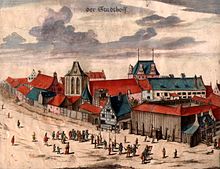Ulica Wojciecha Bogusławskiego
The Ulica Wojciecha Bogusławskiego (German Wojciech-Bogusławski-Straße , until 1945 at the Reitbahn ) is a street in the city center of Gdansk . It is named after the Polish theater director Wojciech Bogusławski .
location
The street is on the western edge of the right town . It leads from the High Gate along the Coal Market (Targ Węglowy) to the Old Town Trench (Podwale Staromiejskie) in a north-south direction. Side streets are Langgasse ( ul. Długa ) and Hundegasse ( ul. Ogarna ). Today's street layout differs somewhat from the historical one in the southern part.
history
17th century to 1945
Until around 1610, the area was located directly outside the city wall of the Rechtstadt. After the construction of the new fortifications, some buildings were built on the inside. In 1635 a wooden fencing school was built, which has since served as a theater. In 1800 a riding school was built in its place. The adjacent street was later named after this.
The west side of the street was also built in the 1860s, and in 1878 the Great Synagogue was built on the site of the riding school. In the 1920s there was a tram, the buildings were used by companies as headquarters or branches, and there were a few small businesses. The residents were directors, merchants, lawyers, doctors, but also employees.
In 1939 the synagogue was demolished. In 1944/45 almost all buildings were destroyed.
Since 1945
In 1945 the street was renamed Ulica Kredytowa (about Bank Street ). The bank building No. 2 was restored. Since 1953 the street has been named after the Polish theater director Wojciech Bogusławski (1757–1829), the father of the Polish theater , in memory of the fencing school with the theater performances in the 17th and 18th centuries. Century.
From 2011 to 2014 a new theater in the style of the English Elizabethan theater was built at its historical location .
building
Current development
The street is hardly built on at the moment. There are among others
- No. 1 (old No. 10–13) Shakespeare Theater , since 2014
- No. 2 (old No. 2) bank building from 1905, BNP Paribas as a branch (as of 2020)
Historical development
Business and residential buildings stood at the riding arena until 1945. The numbering began at the coal market on the western side, went to the old town ditch to the south and from there on the opposite side back to the coal market ( horseshoe shape ). Some users and residents are given
- No. 1 floor tower
- No. 2 before 1830–1905 Hotel de Marienburg
- 1876–1922 Landschaftliche Bank AG, 1922–1940 Landwirtschaftliche Bank AG, 1940–1945 Danzig-Landschaft West Prussia
- No. 4 after 1920 Polish General Commissariat (diplomatic representation of the Republic of Poland in Gdansk); Polish government treasury
- No. 4a 19th century – after 1926 official residence of the police president
- No. 7 1911–1914 French diplomatic mission in Danzig
- No. 10–13 1635 – around 1741 Fencing school with theater performances
- 1800 – around 1860 riding school
- 1878–1939 Great Synagogue
- No. 14? –1945 fire station (main entrance to Hundegasse)
- No. 22/23 after 1850–1870 Johann Samuel Keiler liqueur factory; 1870-after 1942 Keiler JS Likörfabrik Nachf. Inh. Eschert and Holtz
- Langgasser Gate
literature
Web links
- At the Reitbahn Institute for Road Science
- Mention of riding arena Gedanopedia (Polish)


